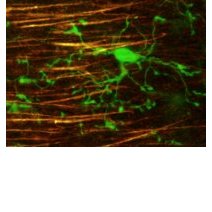Microglia activation triggers astrocyte-mediated modulation of excitatory neurotransmission.
Pascual O, Ben Achour S, Rostaing P, Triller A, Bessis A.
Fine control of neuronal activity is crucial to rapidly adjust to subtle changes of the environment. This fine-tuning was thought to be purely neuronal until the discovery that astrocytes are active players of synaptic transmission. In the adult hippocampus, microglia are the other major glial cell-type. Microglia are highly dynamic and are closely associated with neurons and astrocytes. They react rapidly to modifications of their environment and are able to release molecules known to control neuronal function and synaptic transmission. Therefore, microglia display functional features of synaptic partners, but their involvement in the regulation of synaptic transmission has not yet been addressed.
We have used a combination of pharmacological approaches with electrophysiological analysis on acute hippocampal slices and ATP assays in purified cell cultures, to demonstrate that activation of microglia induces a rapid increase of spontaneous excitatory post-synaptic currents (EPSC). We found that this modulation is mediated by binding of ATP to P2Y1R located on astrocytes and is independent of TNFα or NOS2. Our data indicates that upon activation, microglia rapidly release small amount of ATP and astrocytes in turn amplified this release. Finally, P2Y1 stimulation of astrocytes increased EPSC frequency through an mGlur5-dependent mechanism.
These results reveal for the first time microglia as a genuine regulator of neurotransmission and place microglia as an upstream partner of astrocytes. Because pathological activation of microglia and alteration of neurotransmission are two early symptoms of most brain diseases, our work also provides a basis for understanding synaptic dysfunction in neuronal diseases.
Microglia (in green) are closely aposed to neurons (in gold). Pascual et al. have now shown that stimulation of microglia rapidly modulate AMPAergic synapses via astrocytes.
Proc Natl Acad Sci USA doi:10.1073/pnas.1111098109


